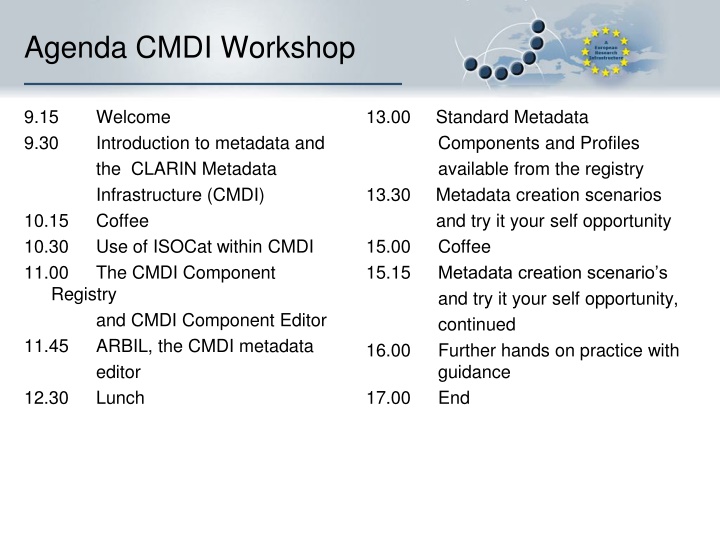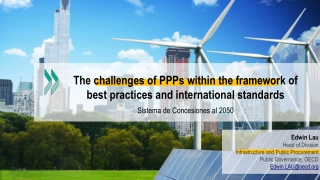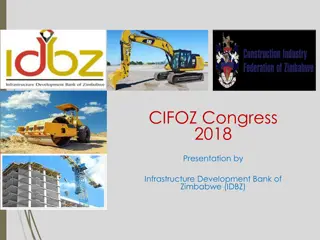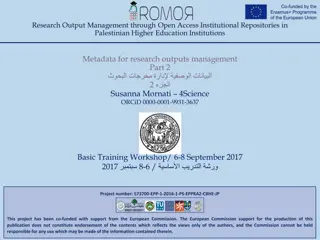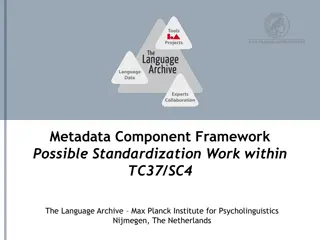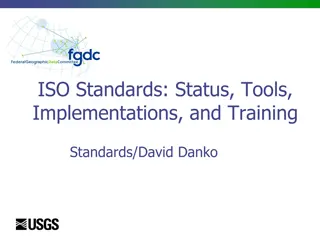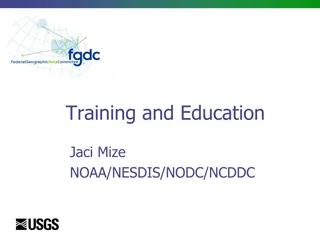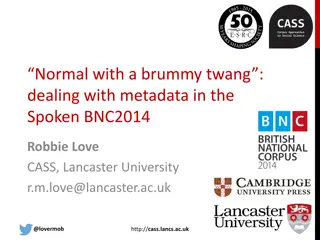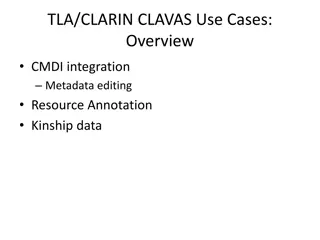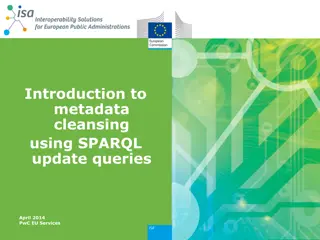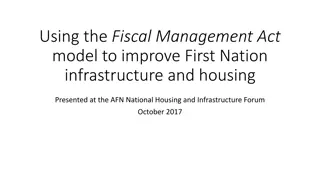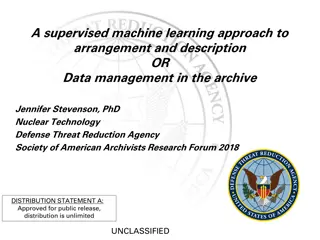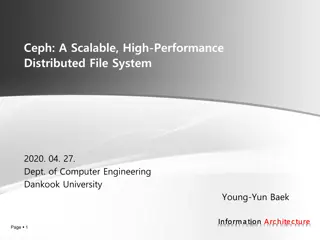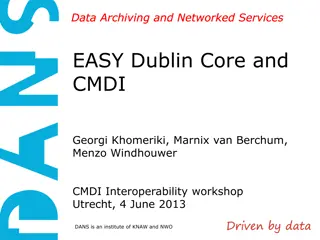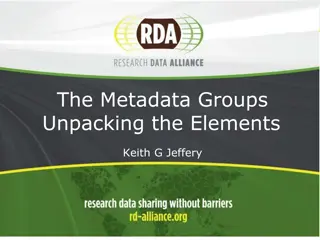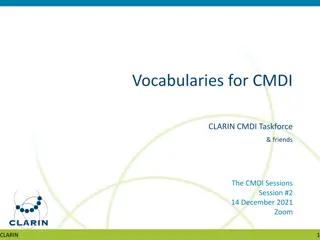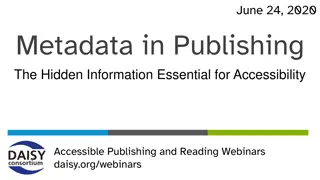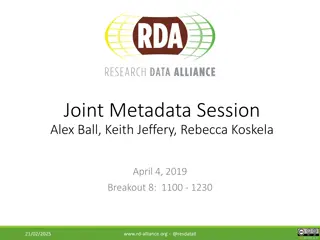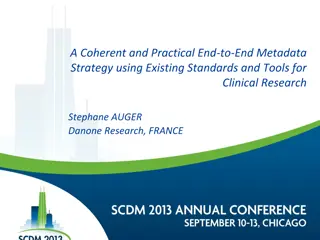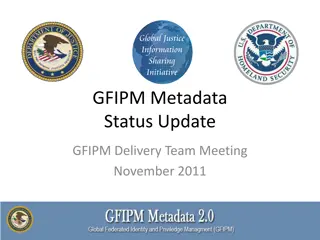Overview of CMDI Metadata Infrastructure
The agenda outlines a workshop on CMDI metadata infrastructure, including an introduction to metadata, use of ISOCat, CMDI component registry, ARBIL metadata editor, standard metadata components, metadata creation scenarios, and hands-on practice sessions. It also provides insights into the background of CLARIN metadata projects and Dublin Core metadata sets.
Uploaded on Mar 21, 2025 | 1 Views
Download Presentation

Please find below an Image/Link to download the presentation.
The content on the website is provided AS IS for your information and personal use only. It may not be sold, licensed, or shared on other websites without obtaining consent from the author.If you encounter any issues during the download, it is possible that the publisher has removed the file from their server.
You are allowed to download the files provided on this website for personal or commercial use, subject to the condition that they are used lawfully. All files are the property of their respective owners.
The content on the website is provided AS IS for your information and personal use only. It may not be sold, licensed, or shared on other websites without obtaining consent from the author.
E N D
Presentation Transcript
Agenda CMDI Workshop 9.15 9.30 Welcome Introduction to metadata and the CLARIN Metadata Infrastructure (CMDI) Coffee Use of ISOCat within CMDI The CMDI Component Registry and CMDI Component Editor 11.45 ARBIL, the CMDI metadata editor 12.30 Lunch 13.00 Standard Metadata Components and Profiles available from the registry 13.30 Metadata creation scenarios and try it your self opportunity 15.00 Coffee 15.15 Metadata creation scenario s and try it your self opportunity, continued 16.00 Further hands on practice with guidance 17.00 End 10.15 10.30 11.00
CMDI CLARIN Component Metadata Infrastructure Daan Broeder et al. Max-Planck Institute for Psycholinguistics CLARIN NL CMDI Metadata Workshop May 27 th Nijmegen
CLARIN metadata project background CLARIN EU WP2 since 2007 investigated and creates (prototypical) solutions for: Common AAI infrastructure Single system of persistent identifiers (PIDs) for resources Common metadata domain - CMDI CMDI is being developed by CLARIN partners: Austrian Academy, IDS, MPI for Psyl, Sprakbanken Univ. Gothenborg, National CLARIN projects: CLARIN-NL, (D-SPIN) CLARIN- DE have committed resources to work with CMDI CLARIN NL metadata project has been testing the CMDI basics
Metadata in General Data about Data Structured Data about Data Not a prose description (although that can be a part) but keyword/value type of data: Name = myresource , Title = mybook Internet: Machine readable Data about Data XML format. Used for: Resource discovery / accessing Management
Dublin Core (DC) Metadata Set Content Intellectual Property Creator Publisher Contributor Rights Instance Title Subject Description Language Relation Coverage Source Date Type Format Identifier
DC Example Qualifiers either specify: encoding scheme refinement DC.Title = My first book DC.Title /Alternative = My last book DC.Creator = L. Smith DC.Subject /LCSH = Building DC.Description/Abstract = . DC.Language/ ISO639-2 = eng
Metadata for Language Resources I Resource types: Video, audio, pictures, annotations, primary texts, notes, grammars, lexica, Different levels of description (granularity): complete corpora e.g. Brown Corpus. sub corpora or corpus components: e.g. all Flemish recordings in the Spoken Corpus Dutch with all the transcriptions (recording) sessions: e.g. the recording of a dialogue (sound file + transcript) individual resources: e.g. a text file
Metadata for Language Resources II Metadata was/is often embedded in annotations CHAT format TEI Advantage of splitting this: Independent formats allowing combinations as IMDI metadata with CHAT annotations Keep several versions for different tools but danger of inconsistencies
Current Metadata Situation Fragmented landscape Metadata sets, schema & infrastructures in our domain: IMDI, OLAC/DCMI, TEI Problems with current solutions: Inflexible: too many (IMDI) or too few (OLAC) metadata elements Limited interoperability (both semantic and functional) Problematic (unfamiliar) terminology for some sub- communities. Limited support for LT tool & services descriptions
Common metadata domain Why a common metadata domain: Finding and sharing resources housed at all archives & repositories participating in CLARIN Specify distributed heterogeneous collections of LRs and processing these collections In general, a common metadata domain helps bringing along a single domain of LRs
Metadata Components CLARIN chose for a component approach: CMDI NOT a single new metadata schema but rather allow coexistence of many (community/researcher) defined schemas with explicit semantics for interoperability How does this work? Components are bundles of related metadata elements that describe an aspect of the resource A complete description of a resource may require several components. Components may use and contain other components Components should be designed for reusability
Metadata Components Lets describe a speech recording Sample frequency Format Size Technical Metadata
Metadata Components Lets describe a speech recording Name Language Id Technical Metadata
Metadata Components Lets describe a speech recording Name Actor Age Sex Language Language Technical Metadata
Metadata Components Lets describe a speech recording Continent Country Address Location Actor Language Technical Metadata
Metadata Components Name Contact Lets describe a speech recording Project Location Actor Language Technical Metadata
Metadata Components Lets describe a speech recording Project Location Actor Metadata schema Language Technical Metadata Metadata profile
Metadata Components Lets describe a speech recording Project Location Actor Metadata schema Language Technical Metadata Metadata description Metadata profile
Metadata Components Lets describe a speech recording Project Location Profile definition XML Actor Metadata schema W3C XML Schema Language Technical Metadata Component definition XML Metadata description XML File Metadata profile
CMDI Component Reuse Component registry User selects appropriate components to create a new metadata profile or an existing profile Location Country Coordinates Text Language Title user Actor BirthDate MotherTongue Recording CreationDate Type Dance Name Type Selecting metadata components from the registry
Concept registries Basically a list with concepts and their descriptions where every concept has a unique identifier. Some have a complicated structure and are associated with elaborate (administrative) processes to determine the status and acceptation of concepts in the registry. e.g. ISO- DCR. others are static and simple lists of concepts and descriptions e.g. DCTERMS
CMDI Explicit Semantics Component registry User selects appropriate components to create a new metadata profile or an existing profile Location Country Coordinates Text Language Title user Semantic interoperability partly solved via references to ISO DCR or other registry Actor BirthDate MotherTongue Recording CreationDate Type Dance Country dcr:1001 Language dcr:1002 BirthDate dcr:1000 ISOcat concept registry Name Type DCMI concept registry Title: dc:title Selecting metadata components from the registry
CMDI Metadata Live-cycle Perform search/browsing on the metadata catalog using the ISO DCR and other concept registries and CLARIN relation registry Create metadata schema from selection of existing components. Allow creation of new components if they have references to ISOcat Search Service ISOcat Concept Registry Semantic Mapping Relation Registry CLARIN Component Registry DCMI Concept Registry Joint Metadata Repository Metadata harvesting by OAI-PMH protocol other Concept Registry Metadata descriptions created Metadata Repository Metadata Repository Metadata component profile was selected from metadata component registry
CMDI Architecture I The CMDI takes an archivist or production first viewpoint Prioritize that the metadata can be of good quality: consistent, coherent, correctly linked to the concept registries The consumer side can be more experimental and diverse. Many MD exploitation stacks or consumers applications can work in parallel on the same metadata
CMDI Architecture II ISO TDG Virtual Collection Registry Metadata modeler MD Catalog ISO-Cat DCR user Semantic mapping Services MD MD Comp. Editor MD Comp. Registry Services Relation Registry External agents MD Editor. MD Creator OAI-PMH Data provider OAI-PMH Service Provider Local MD Repository CLARIN Joint MD Repository
Current CMDI status I ISO-DCR: 218 metadata concepts CMDI component registry: 135 components, 19 profiles Produced & inspired by: Deconstructing existing metadata schema IMDI, OLAC, TEI Considering requirements of other CLARIN activities like profile matching CLARIN NL metadata project tested the CMDI model and delivered components and profiles for the resources in two major Dutch Language Resource centers
Current CMDI status II Operational or test phase: ISOCat DCR Component registry & editor ARBIL metadata editor Still working on: Joint Metadata Repository, Metadata Catalog, Semantic Mapping, Relation Registry Expect a usable first version in third quarter 2010
Thank you for your attention CLARIN has received funding from the European Community's Seventh Framework Programme under grant agreement n 212230
